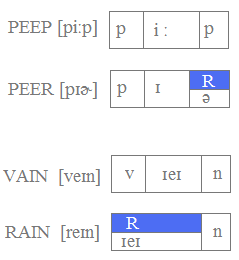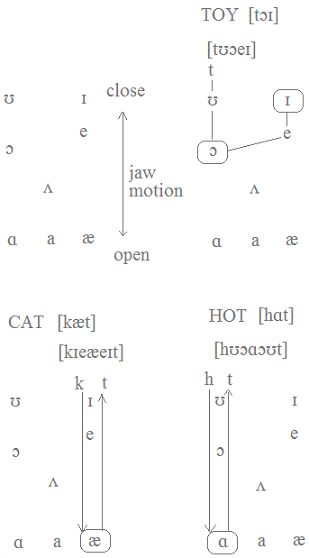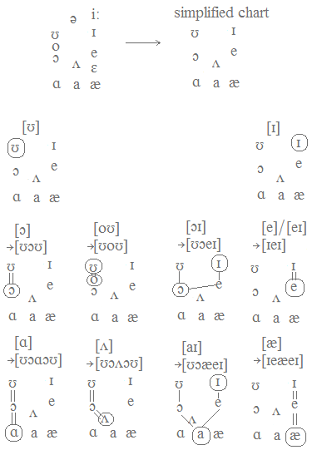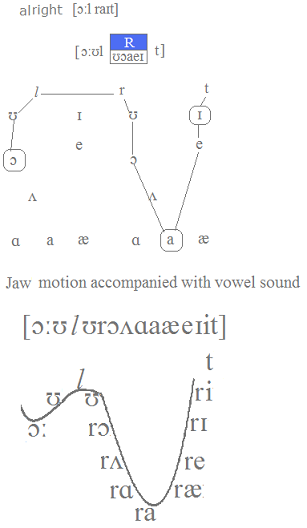日本語 ____ Français ____ English ____ Italiano ____ Español ____ Deutsch ____ Português
tokyomaths.com
[HOTEP] Horizontally Open Tongue English Pronunciation and
«Vowel Sliding©»
The English consonants pronunciation with the horizontal open and flat tongue.
The consequent necessity of the down and up motion of the jaw.
Also;
«R-mode©»,
«R-modification©» and
«vowel sliding©».
©2007 tokyomaths All rights reserved. A protected expression.
Warning ; Any kind of plagiarism of the expressions and ideas on this page, without acknowledging the source “tokyomaths.com”, will be very severely accused by tokyomaths.com
On this page, you will find the description on an original manner of understanding the American pronunciation for people who are learning English as a foreign language. (EFL)
The four important points for American pronunciation.
· All consonants are pronounced with the horizontal immobile flat tongue.
· A large open-close motion of the jaw for the pronunciation of intermediate vowels and open vowels.¤
· R-modification of vowels. R is not an independent consonant, but a mode of modification of the vowels.
· “Vowel sliding”; an intermediate vowel is pronounced passing through its close vowel before and after, and an open vowel is pronounced passing through its close vowel and intermediate vowel before and after.
A way of pronunciation for English done without any movement of the tongue, which remains open at the lowest position in the mouth: that is the axiom, (i. e., the major premise at the starting line), posed in [HOTEP]. The horizontal tongue does not do any vertical motion of its tip. “Open tongue”, it means also that the tongue remains laterally flat, left and right. Since the tongue does not move, the positional relation between the palate and the tongue for the pronunciation of each consonant is determined principally by the motion of the lower jaw.
English as a foreign language
Please verify that the tip of your tongue does not touch the palate vertically, as saying: “LA LA LA LA”. If it is the case, the pronunciation is done without jaw movement. The consonants are too strong and too clear, and the vowels are too closed. The pronunciation of an open vowel does not pass through closed vowels before and after. Concerning the people who speak with movements of the tip of the tongue, the tip of the tongue is always in a very high position in the mouth. The people who speak a language in which the tip of the tongue touches the palate vertically do not have habit of moving the jaw, and their jaw remains always in the middle position. The people who speak with movements of the tongue cannot understand the necessity of movements of the jaw, and the up and down movements of the jaw of the Americans people may look weird. Why the tongue of Americans people who speak is always visible from the outside?
(1) Pronunciation of R
“R-colored vowel” and “R-modification”

In [HOTEP], R is not a consonant. R is considered as a modifier of vowels. The R-modification of vowels is done by a lowering of the tip of the tongue. The tip of the tongue does not go up. Under R-modification, the entire length of the vowel will be affected. R is heard always as a vowel under an R-modification; R as an independent consonant does not exist. The sound of the consonant R in a general sense is nothing but a schwa under R-modification. A vowel under R-modification should not be omitted even if you speak very fast.
Generally speaking, R sound in English pronunciation is considered as a consonant sound. tokyomaths.com suggests to the people who learn English pronunciation to consider R as a modifier of vowels: R is not a vowel, but a modifier of vowels. An R-modification is done by a lowering of the tip of the tongue with its vowel: one of all vowels, schwa included. The sound of the consonant R, that English teachers show to their students, is nothing but a schwa under R-modification. Under R-modification, the entire length of the vowel will be affected. R cannot be an independent consonant.
“R-colored vowel” and “R-modification”
N. B.,
dry-eyed [drʊɔaeɪ ɪeaeɪd]
may I [mɪeɪ ɪeaeɪ]
etc.
Therefore,
rt+vowel [ɚd+vowel] (artist [ɑɚdɪst], starter [stɑɚdɚ])
(2) Correct pronunciation of English consonants.
If you use the tongue to pronounce consonants, it will be difficult for you to notice that your consonants are too clear.
[ʦ][ʣ][p][b][m][t][d][ʧ][ʤ][n][l][w][f][v][θ][ð][s][z][j][ʃ][ʒ][ŋ][k][g][h]
([r] is not included.)
For the pronunciation of each consonant, the jaw is necessarily in a very high position. The English pronunciation requires the downward movement of the jaw for the open vowels, and the upward movement for the consonants. In the almost closed mouth, the tongue can only be horizontal, and the muscle around the mouth is not used to close the lips. The movement of the tongue is limited, also movement of the lips is limited, therefore the expression of the characteristic sound of each consonant is physically limited. The vowel that follows directly a consonant is a closed weak vowel ([ɪ][i][ə][ʊ]), and the other vowels ([e][æ][ɑ][ɔ][o][ʌ][a], etc.) cannot directly follow a consonant. Microscopically, the sounds of the syllables, such as [hæ][bɑ][kʌ][ʧɔ], etc., etc., don’t exist, because a consonant is not pronounced with a movement of the tongue in the mouth that is already open, and also because an open vowel is not pronounced in the mouth that is not open enough.
[ʦ][ʣ][p][b][m][t][d][ʧ][ʤ][n][l][w][f][v][θ][ð][s][z][j][ʃ][ʒ][ŋ][k][g][h]
([r] is not included.)
Every consonant is pronounced with the horizontal tongue. There is no upward movement of the tongue tip. It is not the movement of the tongue tip, but the upward movement of the jaw that makes these consonants. The movement of the jaw is difficult to execute for the people who use the vertical tongue for consonants. Exercises will be required.
With the vertical movements of the tongue tip, the consonants are too strong and too big. The beautiful sounds of the consonants are very small and very weak with the horizontal tongue.
Pronunciation of “TH” [θ] [ð]
The tip of the tongue is placed on the lower front teeth. Then an upward movement of the jaw.
Pronunciation of “L” [l]
Very often, an English teacher shows his tongue to explain the pronunciation of L. In his opened mouth, his tongue is vertical in order to show that the tongue is touching the upper front teeth, because he cannot show it with his mouth closed. L sound cannot be pronounced with the vertical tongue tip. “LA LA LA” must be pronounced with the horizontal tongue, jaw motion and vowel sliding. Saying “LA, LA, LA, LA, LA, LA”, if your jaw does not move, you need some exercises of L, doing the tip of the tongue like TH.
Pronunciation of “H” [h]
R is a mode of vowel and does not require jaw closing. R can be pronounced at any position of the jaw. Also, H does not require jaw closing. H is a unvoiced mode of vowel, however, as the vowels are all voiced, the H mode will be immediately crushed by the vowel itself. H mode of vowel is logically an impossible sound, and H is used as an unvoiced consonant at the beginning of words.
H sound should not be made by a friction on the inner part of the tongue. H is a very weak sound and can be sometimes omitted.
Pronunciation of B, P, M, [b] [p] [m]
For the pronouciation of B, P and M, it is a mistake to close the lips without moving the jaw. The lips have to be closed by an upward motion of the jaw. English pronounciation does not use the muscle for the lips.
Pronunciation of S, Z, [s] [z]
The tongue remains always in a low position for the pronunciation of S and Z. The tongue does not touch the palate.
For the pronunciation of all consonants, the tip of the tongue is in contact with the lower front teeth at all times. (For “R”, the tongue tip is lower than the gums of the lower incisors.)
(3) Pronunciation of the vowels
The understanding of the big motion of the jaw is necessary for the understanding of the phenomenon of vowel reduction, which occurs when there is no movement of the jaw. Rapid syllables of schwa [ə], it means there is no movement of the jaw.

“Vowel Sliding”
In English pronunciation, an open vowel is pronounced as passing through its close vowels before and after. The vowels that are on the passing points are named “intermediate vowels”.
©2007 tokyomaths All rights reserved. A protected expression.
«Vowel Sliding©»
In English pronunciation, an open vowel is pronounced as passing through its close vowels before and after.
©2007 tokyomaths All rights reserved. A protected expression.
For better understanding of the idea of “vowel sliding”, it must be explained with
(1) the description of the horizontal tongue for all consonants,
(2) the description of the large motion of the jaw for stressed syllables and
(3) the definition of the schwa.

A “vowel sliding” occurs by an opening-closing motion of the jaw on each one of the accented vowels. Very often people who learn English are wrong to think that each phonetic symbol for vowel is a straight sound, because they don’t know the necessity of the jaw motion: necessity, because the horizontal tongue needs jaw movement to pronounce correctly the consonants. For an accented syllable, after the consonant (or the group of consonants, or without consonant), if the vowel is pronounced with the open jaw, the jaw needs to pass through the positions of close vowel to open vowel, and after the aimed vowel, the jaw needs to go up to the close position. Therefore, the pronunciation of the aimed open vowel must be preceded by a sliding change of sound-motion of close vowels, and must be followed by a sliding change of sound-motion of close vowels again. A preceding sliding and following sliding are not always symmetric, because of a diphthong or according to the following syllable. It is something like; to go somewhere, you must pass through the intermediate spots on the way and come back too.
A “vowel sliding” occurs on each one of the accented vowels. Therefore, “vowel sliding” is clearly distinguished from “gliding vowel”, which is only between the two phonetic elements of a diphthong: just as “a diphthong must be pronounced smoothly”. Also, “vowel sliding” is not the linking between two vowels.
“Vowel Sliding” must be explained with the description of the horizontal tongue for all consonants, the description of the large motion of the jaw for stressed syllables and the definition of the schwa. “Vowel Sliding” is clearly distinguished from “gliding vowel” in a diphthong. Also, “Vowel Sliding” is a “closing-opening-closing” of the jaw and the sound on each one of the accented vowels, and not the linking between two vowels.
What is «vowel sliding©».
With the exception of r, all consonants are pronounced with the jaw closed, and an open vowel is pronounced with the jaw opened. Therefore an open vowel that follows directly a consonant is impossible. For example, for the word “fast”, [f] is pronounced with the closed jaw, [æ] is pronounced with the open jaw, therefore, after [f], the vowel sound must pass through [e] and [ɪ] to get to [æ]. The sound [fæ] is impossible. Then, to make [st], the vowel sound must pass through [e] and [ɪ] with a closing jaw motion. [fæst] must sound like [fɪeæeɪst]. It is also possible to use schwa as [fəeæeəst]. Anyway, if you speak with tongue movements, and, as a result, if you speak without jaw movements, and if you pronounce the consonants without closing the jaw, you will not understand this.

Vocabulary
The pronunciation of consonants has something of the entire syllable that follows their syllable, as a preparation in the mouth.
For example, in the pronunciation of the word “herself”, the pronunciation of [h] has already some preparative movement for “self” in the mouth. For the chunks of several syllables of a word or a phrase, its syllables are not pronounced one by one, but several syllables are pronounced simultaneously. Just like when we watch a picture, we don’t see its parts one after another, but we see simultaneously all its parts.
©2007 tokyomaths All rights reserved. A protected expression.
